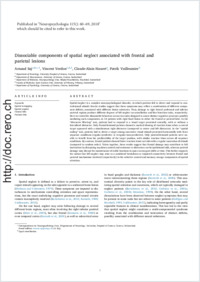Dissociable components of spatial neglect associated with frontal and parietal lesions
- Saj, Arnaud Department of Neurology, University Hospital of Geneva, Switzerland - Department of Neurosciences, University of Geneva, Switzerland
- Verdon, Vincent Department of Medecine, Neuropsychology Unit, Hôpital Neuchâtelois, Neuchâtel, Switzerland - Faculty of Medecine, Sport Sciences Unit, University of Fribourg, Switzerland
- Hauert, Claude-Alain Department of Psychology, University of Geneva, Switzerland
- Vuilleumier, Patrik Department of Neurosciences, University of Geneva, Switzerland
-
01.07.2018
Published in:
- Neuropsychologia. - 2018, vol. 115, p. 60–69
English
Spatial neglect is a complex neuropsychological disorder, in which patients fail to detect and respond to contralesional stimuli. Recent studies suggest that these symptoms may reflect a combination of different component deficits, associated with different lesion substrates. Thus, damage to right lateral prefrontal and inferior parietal regions produce different degrees of left neglect on cancellation and line bisection tasks, respectively. Here we tested for dissociable behaviors across two tasks designed to assess distinct cognitive processes possibly mediating such components, in 14 patients with right focal lesion in either the frontal or parietal lobe. In the “distractor filtering” task, patients had to respond to a visual target presented centrally, with or without a lateralized distractor. Only frontal-lesioned patients showed a marked slowing of reaction times when a central target appeared with a simultaneous right distractor (compared to center and left distractor). In the “spatial coding” task, patients had to detect a target among successive visual stimuli presented horizontally with three sequence conditions (regular/predictive or irregular/non-predictive). Only parietal-lesioned patients were unable to benefit from the predictability of the target position, with similar reaction times across all sequence conditions. By contrast, frontal patients showed faster reaction times on trials with a regular succession of stimuli (compared to random order). Taken together, these results suggest that frontal damage may contribute to left inattention by disrupting top-down control and resistance to distractors on the ipsilesional side, whereas parietal damage may disrupt the maintenance of stable locations in space across gaze shifts or time. This further supports the notion that left neglect may arise as a combined breakdown or impaired connectivity between frontal and parietal mechanisms involved (respectively) in the selective control and memory storage components of spatial attention.
- Faculty
- Faculté des sciences et de médecine
- Department
- Département de Médecine
- Language
-
- English
- Classification
- Biological sciences
- License
-
License undefined
- Identifiers
-
- RERO DOC 323458
- DOI 10.1016/j.neuropsychologia.2018.02.021
- Persistent URL
- https://folia.unifr.ch/unifr/documents/307426
Statistics
Document views: 102
File downloads:
- pdf: 257
